Lessons in branding from the NHL
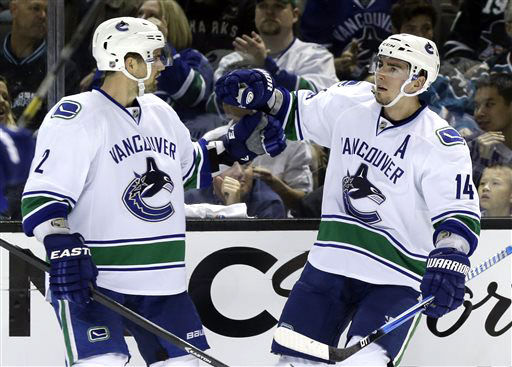
The Vancouver Canucks are out of the 2013 playoffs after only four games. It hasn’t been their best year. But the Canucks are my team, and I’ll be a fan regardless of how far they make it in any year.
What can business learn from the branding programs of NHL teams?
While watching a live game against the Anaheim Ducks a few weeks ago, I was struck by the huge contrast in branding between the Canucks and the opposing team. While the Canucks imagery, from colors to jerseys to logo to other aspects of their marketing, sparkles with energy and hipness, the Ducks symbolism is visually empty and uninspiring. When you take everything into consideration, the Canucks have what I believe to be among the best branding in the NHL. But it hasn’t always been that way. For years the Canucks had truly bad branding. This post examines what business can learn from the branding programs of several NHL teams.
Basic requirements of sports branding
A number of things make sports team branding more complex than any other. You not only have the usual issues of creating an image that represents the essence of your organization, but you have to integrate the essence of the team’s community at the same time. There have to be aspects of the image that the community can relate to, either because of the city’s culture or its history.
In addition to the geographic sensitivity, the symbolism needs to show aggressiveness. This aggressive touch needs to be attractive to men and women alike. Make it too masculine or too warrior-like and you’ll turn off female fans.
A sports team logo must also be flexible enough to work equally well in opposing uniform colors, dark and light for home and away games.
It has to be a visual that can adapt to fan merchandise easily, everything from flags and banners to mugs and ball caps.
Finally, the symbol has to be designed to look great on the front of a uniform. This means a design that isn’t too wide or too high because those look awkward in the confined space of a jersey. Most great sports logos fit into a circular or square structure for this reason.
An example of branding that fails on all counts
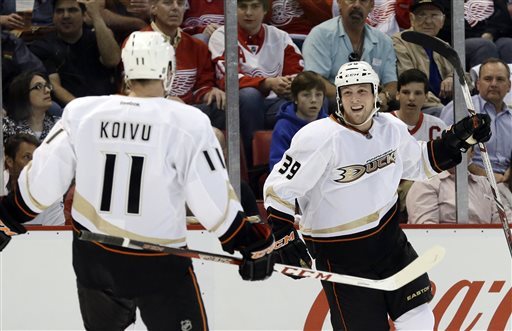
In my view, the worst branding in the League has got to be that of the Anaheim Ducks. Not only does the logo break most of the rules of sports branding, it has a wimpy color scheme as well.
 I can’t imagine that the designer of this logo has ever designed a sports team logo before, as the shape is very wide and can’t fit onto a jersey without leaving a ton of space above and below the team name. The end result is a look that comes across as boring and lacking energy. The Jersey has so much white space around the logo that it doesn’t have any power.
I can’t imagine that the designer of this logo has ever designed a sports team logo before, as the shape is very wide and can’t fit onto a jersey without leaving a ton of space above and below the team name. The end result is a look that comes across as boring and lacking energy. The Jersey has so much white space around the logo that it doesn’t have any power.
And the whole idea of a duck’s webbed foot as the main visual element seems flat as well. Even the ugly old Disney-inspired logo is better than this new one.
Your logo can help your company grow or it can work against you. The investment you make can mean millions of dollars of sales won or lost. Don’t cheap out or give the project to a family friend to save money. You’ll lose in the end.
Put the focus where it really matters: how one team failed
The LA Kings had a crown as a primary element of their logo dating back to the 1960s. With a name like the “Kings” that makes perfect sense. Even though some of the color choices were a bit weird and the crown design was overly complex, it suited the team. Here’s a look at the team’s logo development from 1967 through 2001:

Development of the LA Kings logo through the years. At left, the logo from 1967. The center logo was adopted in 1982. In 1988 the purple was dropped in favor of a white, gray and black theme. The dotted crown was a consistent element throughout.
 In 2002 the team dropped all the text and used just a big, modernized crown on the front of their jerseys, going back to purple coloring. It actually looked pretty good, despite the overly complex crown design. What made this version work was the size. They allowed the symbol to be big and bold. The name of the team doesn’t need to appear, especially when the logo does such a good job of representing the name.
In 2002 the team dropped all the text and used just a big, modernized crown on the front of their jerseys, going back to purple coloring. It actually looked pretty good, despite the overly complex crown design. What made this version work was the size. They allowed the symbol to be big and bold. The name of the team doesn’t need to appear, especially when the logo does such a good job of representing the name.
Then in 2011 they changed it. What they should have done is drop the purple, which they did, and simplify the look of the crown to make it more modern and more hip, possibly adding in some element that would give it added energy and aggressiveness. But they didn’t. Instead, they decided the name of the city should be front and center, with the crown symbol taking a back seat.
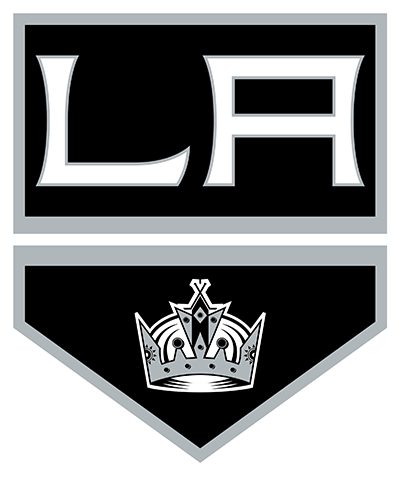 Even worse, rather than making the overly complex crown simpler and cleaner, they just shrunk the entire busy logo down in size so it becomes insignificant but just as busy a design as before. It makes no sense. Then they added the letters “LA” in massive spiky looking letters that don’t have any relationship to the crown, the city or the team. The whole thing now looks ungainly and awkward. The only thing they did right was losing the colors and going back to the distinctive black, gray and white color scheme.
Even worse, rather than making the overly complex crown simpler and cleaner, they just shrunk the entire busy logo down in size so it becomes insignificant but just as busy a design as before. It makes no sense. Then they added the letters “LA” in massive spiky looking letters that don’t have any relationship to the crown, the city or the team. The whole thing now looks ungainly and awkward. The only thing they did right was losing the colors and going back to the distinctive black, gray and white color scheme.
Make sure the focus stays where it belongs. If you need to update your logo, don’t lose the essence of the brand equity you already own. Work towards making the design simpler, not taking something complex in design and shrinking it in size. That just makes the problem worse, because small renditions will no longer hold detail and will fall apart visually.
The power of consistency
The less you change, the more you retain the existing brand capital. The longer a logo continues with few, if any, changes, the more it gains recognition. You can simplify and make slight changes to modernize, but don’t change the essence of the design. The best logos, like McDonald’s, Starbucks and Apple, have gone through very few changes over decades of time. Most people wouldn’t even be able to tell you what the changes were. Any wholesale changes will send the message that you’re starting over, and you’ll lose existing equity.
The same holds true in sports. Let’s look at two teams who have maintained a very consistent look for a long time.
The Boston Bruins
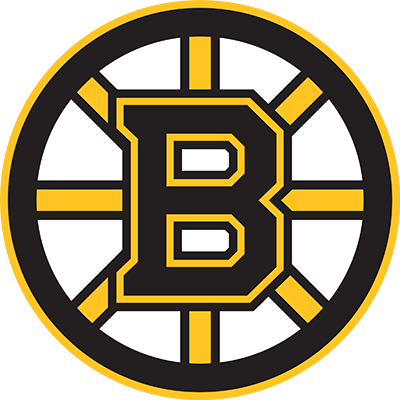 There’s no love lost between the Canucks and the Boston Bruins. But one thing you have to give the Bruins is the power of their logo. The design has hardly changed since 1932, when it consisted of just the letter B in the same style used today. The spokes were added in 1948, perhaps a purposeful reflection of the words of Oliver Wendell Holmes, who called Boston’s State House the “hub of the solar system.” As one of the original six teams, this consistency becomes even more valuable. There will never be a need to change the logo and I hope the team never decides to change it.
There’s no love lost between the Canucks and the Boston Bruins. But one thing you have to give the Bruins is the power of their logo. The design has hardly changed since 1932, when it consisted of just the letter B in the same style used today. The spokes were added in 1948, perhaps a purposeful reflection of the words of Oliver Wendell Holmes, who called Boston’s State House the “hub of the solar system.” As one of the original six teams, this consistency becomes even more valuable. There will never be a need to change the logo and I hope the team never decides to change it.
There are minor variations for different color uniforms, simply affecting whether the spokes or circles are edged with color or not. These variations don’t affect the essence of the symbol in any way. The very first Bruins logo featured the image of a bear, and that appears on the shoulder patch and in other strategic places, like their website.
Toronto Maple Leafs
 The Toronto Maple Leafs are another team that have enjoyed great consistency in branding over a long time. It’s not a great logo by any stretch of the imagination, but it is consistent and that’s what gives it power. The original logo, dating back to 1927, featured the same three words as today, inside a green colored maple leaf.
The Toronto Maple Leafs are another team that have enjoyed great consistency in branding over a long time. It’s not a great logo by any stretch of the imagination, but it is consistent and that’s what gives it power. The original logo, dating back to 1927, featured the same three words as today, inside a green colored maple leaf.

Development of the Leafs logo over the decades. The original logo (left above) appeared in 1927. The next version was adopted in 1939 and was used until 1967. It still appears on the shoulders of the team jerseys. Throughout the team’s history, the essence of the logo remained consistent.
Not long ago, the Toronto Maple Leafs were named as the NHL team with the greatest brand value in the entire league. I’m convinced that the consistency of their logo plays a key role, because it certainly has nothing to do with how they’ve traditionally performed.
Other teams that have enjoyed consistency in their branding are the Detroit Red Wings (great, timeless logo!), Montreal Canadiens and the Chicago Blackhawks.
Don’t make changes unless you really have to, and when you do, never lose the essence of what you had before. The more consistent your symbol remains, the greater your brand equity becomes. Change it and you essentially start over.
The importance of building community support
 Unfortunately, the Vancouver Canucks have made significant changes to their logo and that did hurt the team. They started in 1970 with a simple hockey stick in a blue ice rink shape bordered by white and green. It was designed by Vancouver’s Joe Borovich. The original colors were actually chosen because they were the color scheme of the province’s then-ruling Social Credit political party. It’s interesting that today, these colors so closely align with what Vancouverites have come to identify as representing the city itself. Royal blue and kelly green have become the colors that residents connect immediately with the west coast heritage.
Unfortunately, the Vancouver Canucks have made significant changes to their logo and that did hurt the team. They started in 1970 with a simple hockey stick in a blue ice rink shape bordered by white and green. It was designed by Vancouver’s Joe Borovich. The original colors were actually chosen because they were the color scheme of the province’s then-ruling Social Credit political party. It’s interesting that today, these colors so closely align with what Vancouverites have come to identify as representing the city itself. Royal blue and kelly green have become the colors that residents connect immediately with the west coast heritage.
To the team’s credit, they have returned to Borovich’s simple ice rink logo for their alternate jerseys and wear that design on the shoulders. It remains a fan favorite, even if it would not be acceptable as a primary logo in this day and age.
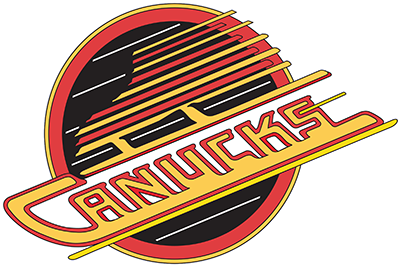 In 1978, the Canucks hired San Francisco branding firm Beyl and Boyd, who had never even seen the Canucks play and seemed to be unfamiliar with Vancouver or its cultural sensitivities. Bill Boyd told the Canucks that there were physical and psychological differences in people’s responses to different colors. He argued that blue and green made people feel colder in the arena, insisting that red and yellow were scientifically more appropriate colors for a hockey team. It was a bunch of mumbo jumbo, typical of what some branding firms use to convince clients to make decisions that defy common sense.
In 1978, the Canucks hired San Francisco branding firm Beyl and Boyd, who had never even seen the Canucks play and seemed to be unfamiliar with Vancouver or its cultural sensitivities. Bill Boyd told the Canucks that there were physical and psychological differences in people’s responses to different colors. He argued that blue and green made people feel colder in the arena, insisting that red and yellow were scientifically more appropriate colors for a hockey team. It was a bunch of mumbo jumbo, typical of what some branding firms use to convince clients to make decisions that defy common sense.
While I generally liked the “hockey skate” logo they designed, it was much too complex and the colors were all wrong for Vancouver. What do the red and yellow colors or the design say about Vancouver? Nothing at all! Even worse, the designers came up with the infamous “halloween” jersey that made the team a laughing stock in the NHL. Surprisingly, the jersey design preceded the skate logo itself.
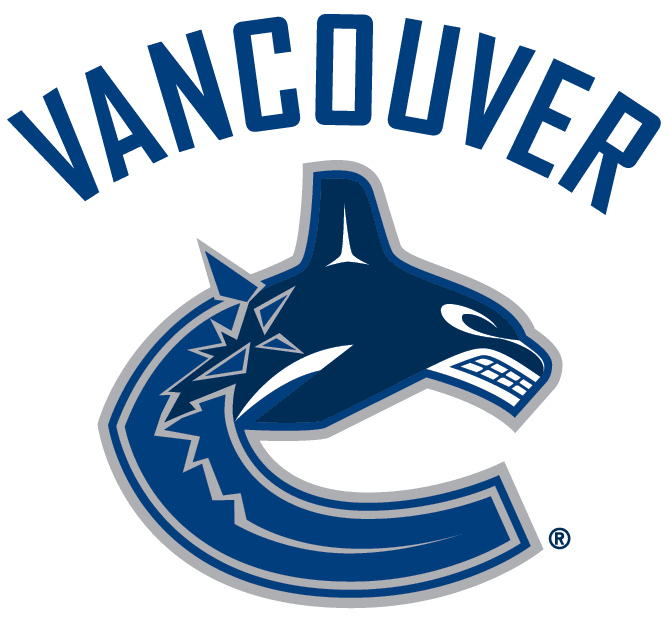 The team’s current logo, featuring the Haida-style Orca bursting out of the ice to create a C shape, was introduced in 1997.
The team’s current logo, featuring the Haida-style Orca bursting out of the ice to create a C shape, was introduced in 1997.
The design, by Vancouver artist Brent Lynch, is fresh and aggressive. It not only reflects the spirit of Vancouver, but the most recent variation (from 2007) prominently includes the name of the city above the logo, making that even more significant than the symbol itself. This is a powerful way to build fan support. How can anyone lack enthusiasm when the name of their hometown appears as the most prominent element of the team’s branding?
When you look at the history of the Orca logo, it has gone through subtle changes over the years. The original design had less contrast and used silver and red tones in addition to the dark blue. The design has matured, taking on white tones for added contrast and losing the red outline. As the color scheme moved ever closer to the green and blue that Vancouver residents identify with, the stronger team support has become.
One of the challenges of sports in Vancouver has been the temporary nature of the city’s cultural climate. Historical value has never really been a part of this city. People are distracted by many recreational opportunities. Nobody stays interested in anything for very long, getting bored and moving on to something new very quickly. For sports teams, this is a major challenge. How do you engage the public so they really commit to the team, like Toronto fans do?
 The solution that Orca Bay, the Canucks’ parent company, chose is to align the team’s branding ever more closely with the city. This is a smart move. The name “Vancouver” is prominently displayed above the logo and thus becomes almost more important than the logo as a brand element. The original ice rink logo also plays a key role by being on the shoulder patch and used as an alternate jersey design. This further reflects the city’s history. All the coloring for all marketing communication uses the iconic blue and green that reflect the city’s identity so closely.
The solution that Orca Bay, the Canucks’ parent company, chose is to align the team’s branding ever more closely with the city. This is a smart move. The name “Vancouver” is prominently displayed above the logo and thus becomes almost more important than the logo as a brand element. The original ice rink logo also plays a key role by being on the shoulder patch and used as an alternate jersey design. This further reflects the city’s history. All the coloring for all marketing communication uses the iconic blue and green that reflect the city’s identity so closely.
And, of course, the Orca logo itself speaks of the west coast cultural heritage. Although some first nations people say it doesn’t have enough Haida elements to accurately represent west coast native art, that’s a detail lost on the vast majority of people. We all understand the relationship to first nations art, even at first glance.
Consider your most important audience. If you want to build community support, include colors or other elements that recognize this audience so that they will identify with your symbolism.
Conclusion
Sports team branding has a tough job to do. Teams need to satisfy a diverse community of fans, build support within their home city and generate long-term fans who will stand by the team and buy seasons tickets even when the team isn’t performing well. Branding plays a key part in accomplishing these goals. Businesses can do well to pay attention to what works and what doesn’t in sports branding.
What are your thoughts on good (or bad) sports branding? Share below.


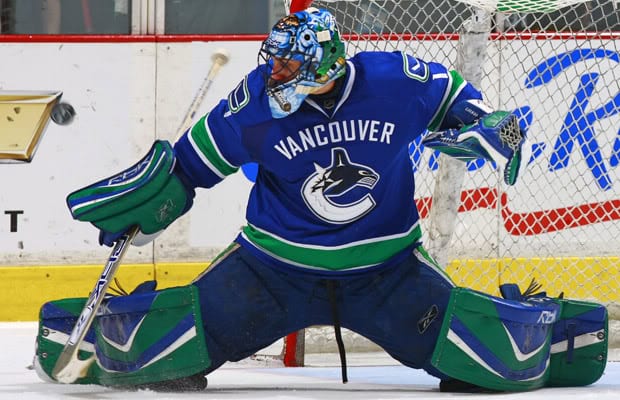
No Comments